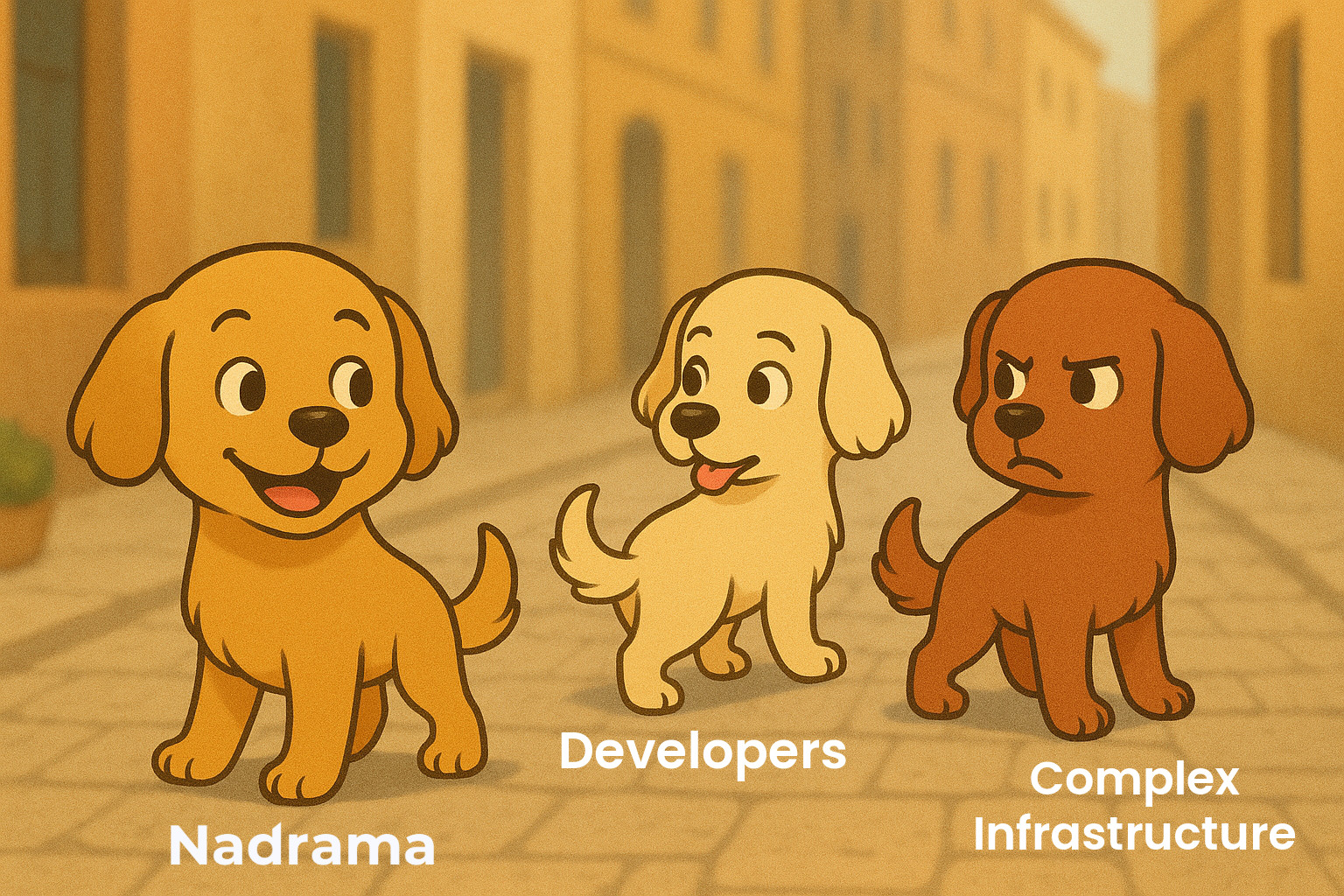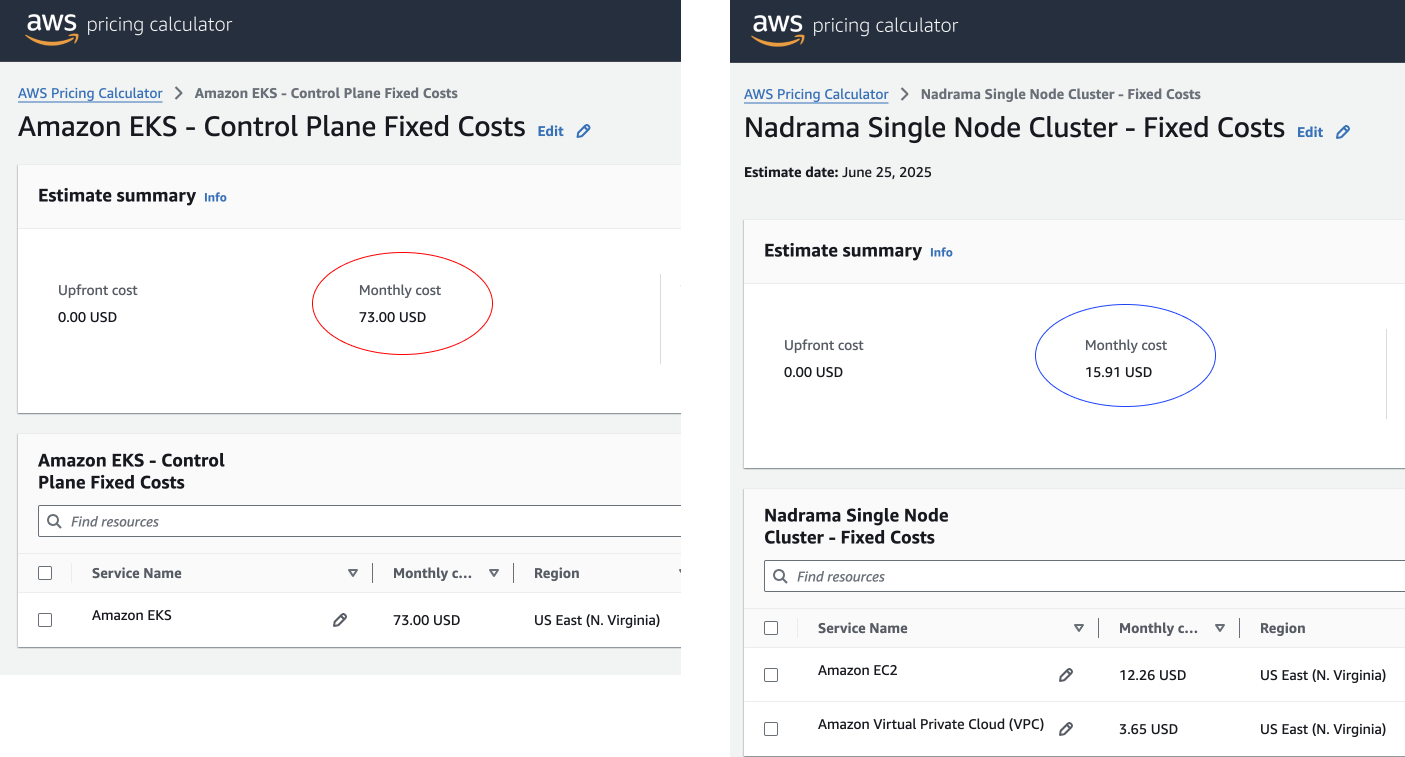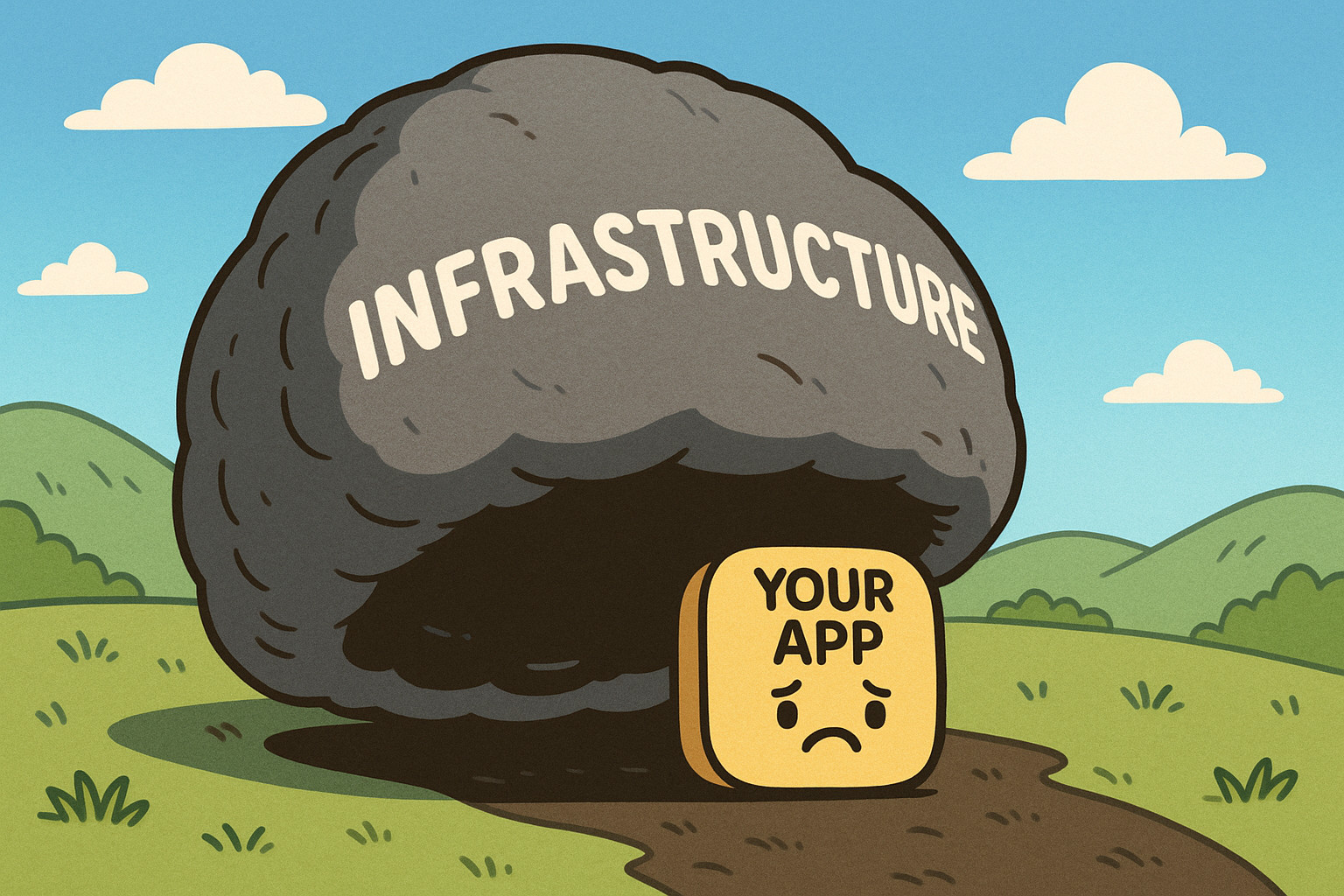< See latest news & posts
How do you set up secure, reliable cloud architecture in the most cost effective way?
TL;DR:
- Infrastructure complexity impairs productivity.
- Every additional infrastructure layer increases attack surfaces, creates more failure modes, can increase vendor lock-in, and compounds costs.
- Nadrama’s hybrid approach runs containers in your cloud account using proven infrastructure primitives while handling orchestration complexity for you.
- Many cloud providers charge $73/month for a managed Kubernetes control plane.
- With Nadrama, you can run a single-node cluster in AWS for less than $16/month.
- Nadrama is built on Kubernetes and open source, so you can lower risk, cost, and complexity, without vendor lock-in.
As a software developer, you’ve mastered the art of designing, coding, building, and deploying great software.
Docker and containers have made it simple to package your app, run it, and push the image.
But when it comes to putting that image into production for real-world use, you face an age-old nemesis: infrastructure complexity.
You’ve already picked a cloud provider and you start with a simple deployment goal of deploying your container, then reality sets in. VPCs and subnet design, IPv4 and IPv6, multi-AZ and load balancing, NAT gateways, DNS, security groups, TLS certificates, the list goes on.
You push through and get things set up. Now you’re worrying about certificate expiry because of the 3am production incident you had last year when they failed to renew and it took down production.
Did you set up automatic renewal and rotation? Will the webserver pick up and use the new cert once it rotates?
 When
you’re drinking coffee at 3am to deal with a production incident
When
you’re drinking coffee at 3am to deal with a production incident
Each requirement spawns three more. Each security and reliability decision introduces risk trade-offs, and on-call pager anxiety. And each new thing inevitably adds to your cloud bill.
Your elegant application gets buried under layers of infrastructure decisions, vendor-specific configurations, and operational overhead. Just reading the aforementioned list probably makes your eyes water.
The Real Problem: Every Layer Multiplies Your Infrastructure Challenges
Infrastructure complexity isn’t just annoying - it’s expensive, risky, and time-consuming. Every additional layer means:
- More attack surfaces to secure and patch
- More failure modes to account for in your disaster recovery plans
- More vendor-specific knowledge your team needs to maintain
- More usage-based and monthly charges that compound faster than you expect
Traditional approaches treat this as inevitable. “Enterprise-grade infrastructure is complex,” they say. “You need all these pieces to be production-ready.”
But what if that’s not true?
A Better Way: Removing Layers While Delivering More
At Nadrama, we believe the best solution is often the simplest one that meets your requirements. Instead of adding more layers and complexity to solve your needs, we remove layers while still delivering enterprise-grade security and reliability, and for the lowest cost possible to you.

Our approach centers on a hybrid architecture that separates concerns intelligently:
- Your data plane runs in your cloud account, using robust, proven, and cost-effective cloud primitives: VMs, network load balancers, and object storage.
- Our control plane handles the complexity of orchestration, cluster state, scaling, and lifecycle operations.
You get an enterprise-grade container platform with direct access to Kubernetes API so you can keep using kubectl, helm, etc. And all starting with infrastructure as simple as a single-VM, running in your existing cloud account.
The result? Your infrastructure footprint shrinks dramatically, without sacrificing on the capabilities you need as you grow and scale, and without excessive costs and vendor lock-in - because we’ve built on Open Source technology like Kubernetes and the best of the Cloud Native software ecosystem.
Making Enterprise Features Accessible to Every Project
Our container platform is already designed to run on the lowest cost cloud primitives in your own cloud account. But here’s where it gets interesting for your hobby projects and development environments…
Traditional container clusters require substantial infrastructure investment. For example, a Kubernetes cluster requires a dedicated etcd cluster for state, typically with 3 VMs.
Or if you opt for a managed Kubernetes service, the going rate is USD $73/month just for the control plane! A non-trivial monthly cost, before you’ve added in any compute to be able to deploy your app.
Nadrama is free for your first single-node cluster. It runs on a VM in your cloud account—typically a t4g.small on AWS with an IPv4 address—which totals under $16/month based on June 2025 pricing. [Link to AWS pricing calculator].
On AWS for example, it’s the cost of a t4g.small instance plus IPv4 address. Note that this excludes standard usage charges like for bandwidth.
 EKS without compute $73 vs Nadrama single node $15.91 in AWS calculator.
EKS without compute $73 vs Nadrama single node $15.91 in AWS calculator.
So for less than $16/month when you run a Nadrama cluster on AWS you get:
- Full Kubernetes API access via a secure tunnel
- Automatic TLS certificate management via cert-manager (built-in)
- Integrated OIDC authentication
- Cilium CNI with overlay networking
- Built-in Traefik ingress controller
- Automatic DNS for your convenience
- Managed patching/instance rotation
Scaling Without Complexity Creep
Low cost hobby solutions are great, but what happens when you need redundancy and scalability?
Many vendors out there try to hook you on their free or entry-level offerings; not us.
From your perspective as a developer, our redundant standard clusters work the same as our single-node clusters.
But using a standard mode cluster means you get multi-node redundancy, public/private subnets, and we manage custom NAT gateways which are more cost-efficient than what you’ll pay for if you used the default managed option in your major cloud.
This means production-grade reliability, at the lowest cost to you. All of this, without changing the way you interface with your cluster - still a Kubernetes API, so you can still use kubectl, helm, etc.
Your Infrastructure Should Amplify Your Code, Not Overshadow It
 Don’t let your infrastructure crush
Don’t let your infrastructure crush you your app
As software developers ourselves, we know that the most elegant systems are often the simplest ones that solve the problem completely.
Complex infrastructure shouldn’t be the price you pay for having a reliable and scalable container management platform.
Nadrama exists to handle infrastructure complexity so you can focus on what you do best: building exceptional software that solves real problems for your customers.
Launch your cluster in a few minutes - no credit card needed.
Sign up and try Nadrama’s free single-node clusters and see how simple production-ready can be.
Frequently Asked Questions
Is a single-node cluster reliable? Yes - ideal for staging, dev, and some production use cases. During instance rotation, we minimise downtime by waiting until the new instance is ready before cutting over the ingress IPs and shutting down the old instance. For true redundancy and high availability, switch to a standard multi-node cluster, and keep using the same tools without having to replatform.
Can I still use kubectl and helm? Absolutely. Nadrama gives you access to the full Kubernetes API via a secure tunnel.
How do TLS certs get renewed? Built-in cert-manager handles automatic rotation and uses Let’s Encrypt by default.
Published: .